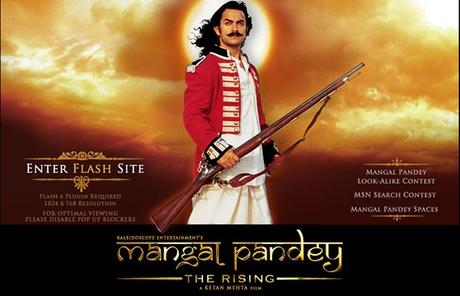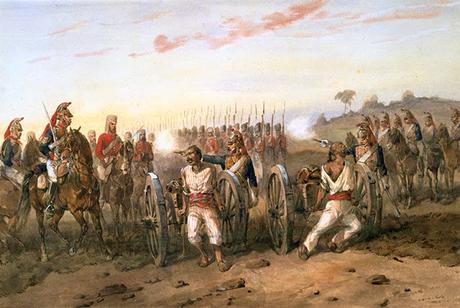கருணை (Kindness) என்பது நன்னெறி; இனிய மனநிலை மற்றும் மற்றவர்களுக்காக கவலைபடக்கூடிய ஒரு இளகிய மன நிலையைக் குறிக்கும் ஒரு நடத்தை ஆகும். இது ஒரு நல்லொழுக்கம் எனவும் அறியப்படுகிறது !!
We were fed a distorted history in our schools and colleges - ‘the uprising of 1857’ not as a National movement, not as a freedom struggle but as sepoy mutiny, only an uprising by a group of soldiers. .. .. and Gandhiji [Nehruji and Congressmen] got us freedom without spilling blood !! ~ British were so kind and noble that they gave freedom on a platter !! Perhaps sons of cow belt soil would remember the movie - Mangal Pandey - The Rising (The Rising - Ballad Of Mangal Pandey) and the hero of the movie. .. .. .. he was not the first man though, and Uprising – the National struggle of 1857 was not the first fight against British East India Company.

It is the life-history of a hero that the Nation must be reading in School books etched in its History – the sad tale of an execution scheduled for April 18 but was carried out ten days before on April 8, 164 years ago. " and that hero was only 26 !! ... if you read History well, do you remember or know, who was the Governor General of British East India Co at the time of the First war of Indian Independence in 1857 ?
On that evening of May 10, 1857, native troops of Bengal Army at Meerut broke out into open insurrection and mutineers marched with triumph towards Delhi ! .. the Britishers were not the kind cats. Genl Neill who proceeded from Calcutta in May 1857 with a regiment to Varanasi & Allahabad had the notoriety for inflicting inhuman cruelties everywhere he went. Though dispassionately and carefully depicted by every British historian as ‘Sepoy Mutiny’ – in 1857 it was great outbreak – an uprising against domineering foreign power and their cruel ways of ruling. Though volumes should have been written on the sacrifices during uprising, History as written by British concisely describes it as uprising in some pockets, duly extinguished by the Generals of East India Company !
It certainly was not as simple .. .. on that significant Sunday in the month of March at the cantonment of Barrackpore, it broke out – in the sepoy lines which had been quiet – most of the sepoys were lounging around, White officers were in their bungalows enjoying their siesta - In the late afternoon, a Sepoy of the 34th Native Infantry, wearing his regimental jacket but in a dhoti instead of the regulation trousers, appeared before the quarter-guard. It was obvious that he was greatly agitated. He had with him a loaded musket and his talwar. He belonged to the 5th Company and his name was Mangal Pandey. The open insolence was not common among sepoys, and a Naik quickly carried the report of Mangal Pandey’s disorderly conduct to Sergeant-Major James Hewson. As the sergeant-major approached Mangal Pandey, the latter took aim and fired. The ball missed Hewson who took shelter behind the bell-of-arms; couple of sepoys tried to persuade Mangal Pandey to surrender his weapons. By this time, the adjutant, Lieutenant Baugh, had arrived on horseback.
It is the story of a hero that the Nation must be reading in School books etched in its History – the sad tale of an execution. "... Plassey had been in 1757 and in the hundredth year after the battle it seemed everyone was awaiting a spark. It was to come in the shape of a new cartridge. The projectile for the new Enfield rifle was part of a self-contained paper cartridge that contained both ball and powder charge. It required the end to be bitten off and the cartridge then rammed down the muzzle of the weapon. To facilitate this process the cartridge was heavily greased - with animal fat. "The preceding months held tensions and several serious events but they failed to cause as big a conflagration as those at Meerut. Fires broke out near Calcutta on 22 January 1857. On 25 February 1857 the 19th Regiment mutinied at Berhampore and the regiment allowed one of its men to advance with a loaded musket upon the parade-ground in front of a line and open fire on his superior officer; a battle ensued. On 31 March 1857 the 34th Regiment rebelled at Barrackpore.
On that fateful day, in 1857, Mangal Pande of the 34th Native Infantry attacked his British sergeant and wounded an adjutant. General Hearsay, ordered a jemadar to arrest him but the jemadar refused. Mangal Pande then turned the gun against himself and used his foot to try to pull the trigger to shoot himself. He failed and was captured, along with the jemadar he was hanged. The whole regiment was dismissed as a collective punishment and because it was felt that they would harbor feelings against their superiors after this incident. Every other sepoys thought of this as harsh punishment.

Barrackpore the headquarters of Barrackpore subdivision in North 24 Parganas district was a military and administrative center under British rule, and was the scene of several acts of rebellion against Britain during the 19th century. Two rebellions against British authority took place in Barrackpore in the 19th century. The first of these was in 1824, led by Sepoy Binda Tiwary. In this rebellion, the 47th Bengal Native Infantry refused to board boats to cross the polluting "dark waters" to Burma in the First Anglo-Burmese War. Consequently, British-manned artillery fired upon and "erased" them. In 1857, Barrackpore was the scene of an incident that some credit with starting the Indian rebellion of 1857 ! All along, the British & the historians preferred to call it the ‘Revolt of 1857’ – which to us is the First war of Independence.
Mangal Pandey was born in village of Nagwa in district Ballia Uttar Pradesh on 19th July 1827 and sacrificed himself for the Nation when he was only 26 ! . The village in which young Mangal opened his eyes was Surhurpur—a small sleepy hamlet, which still retains the dusty rustic look, that speck of golden grime, the wont of Awadh, distinguishing the region from the more greener pastures of east UP. Divakar Pandey, Mangal’s father actually belonged to another village — Dugvaan-Rahimpur in Faizabad Tehsil. Mangal Pandey entered the east India Company Bengal army in 1849. He was 22, a tall lad, lean and well built. Village anecdotes paint him as a man 9 feet tall—this is excusable exaggeration of a legend. Sadly, Mangal’s act of defiance in 1857 did not enthuse the other sepoys instantaneously. Pandey injured two British officers before a sepoy, Sheikh Paltu, held him from behind. Mangal Pandey then tried to shoot himself but only superficially injured the bulging muscles of his chest. He was disarmed by Major-General Hearsey, tried and executed on April 8. It was only a month later that the Mutiny broke out at Meerut on May 10. The next day the rebel sepoys marched to Delhi and entered the city through the Rajghat Gate. Until September, the sepoys held control of Delhi after an orgy of bloodshed.
Though Mangal Pandey did not have any connection with Delhi as such, he nevertheless is a hero and in Meerut, a temple commemorates him. Every sepoy who had rebelled in Delhi and elsewhere was dubbed "Pande" by the British troops and their retaliation was termed "Pande-bashing" ! it is our duty to salute our motherland and remember all those great patriots who gave their tomorrow for our today ..
With regards –S. Sampathkumar8th Apr 2021.
PS : in case you remember or answered the Q at the start – who was the Governor General of British East India Co when the first Indian Independence War broke out in 1857 ?
It was - Charles John Canning, 1st Earl Canning, KG, GCB, KSI, PC (1812 – 1862) also known as The Viscount Canning and Clemency Canning. He was the Governor General during the Indian Rebellion of 1857 and became the first Viceroy of India after the transfer of power from the East India Company to the Crown of Queen Victoria in 1858 after the rebellion was crushed. The Indian Penal Code was drafted in 1860 based on the code drafted by Macaulay and came into force in 1862 during his regime. Canning met the rebellion with firmness and in 1858 was rewarded with post of Viceroy. In Apr 1859, he received thanks of both Houses of Parliament for his great services during the rebellion. He was also made an extra civil grand cross of the Order of the Bath, and in May of the same year he was raised to the dignity of an Earl, as Earl Canning. About a month before his death he was created a Knight of the Garter, as he died without issue the titles became extinct.
Prior to the rebellion, Canning and his wife, Charlotte, had desired to produce a photographic survey of Indian people, primarily for their own edification. This project was transformed into an official government study and was eventually published as an eight-volume work, The People of India, between 1868 and 1875.
Pic of British reprisal execution – credit : https://www.spectator.co.uk/

